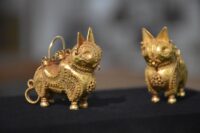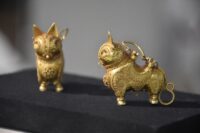A pair of medieval gold earrings shaped like lynxes with minutely intricate decoration are going on display for the first time since they were discovered near the medieval Armenian city of Ani in eastern Turkey.
Ani was founded in the 5th century on a hill overlooking the Akhurian River, the modern border between Turkey and Armenia, at the intersection of several important trade routes on the Silk Road. It prospered and grew over the centuries, reaching its peak in the 11th century as the capital of the Bagratid Armenian kingdom with a population of 100,000 inside the citadel walls. The walls could not ultimately defend it from the onslaught of the Mongols in 1236. They sacked the city, leaving it much reduced in population, and an earthquake in 1319 did even more damage to Ani’s famed churches, monasteries and palaces. Shifting trade routes lessened Ani’s regional prominence, and by the end of the 17th century it had become a ghost town.
The gold lynx earrings were discovered in the village of Subatan, less than 10 miles away from Ani on the Silk Road route that traverses the ruins of the citadel. They weigh 22 grams and are decorated with star, teardrop and crescent shapes applied in granulation technique. They are exquisite examples of medieval Armenian art. The museum acquired the earrings in 1994, but they have been kept in protective storage.
Yavuz Çetin, director of Kars Archaeology and Ethnography Museum, told Anadolu Agency (AA) that Kars has hosted many civilizations throughout history as it is located on the border of countries and is on the historical Silk Road’s route. […]
Çetin noted that people have benefited from animals throughout history and attributed physical or characteristic meanings to them.
“The lynx from the feline family is one of these animals. People were influenced by the ferocity and power of this animal and used it in artistic elements,” he said. “The existence of the lynx is also known in our Kars region.”
They will be exhibited next year at the Kars Archaeology and Ethnography Museum.

